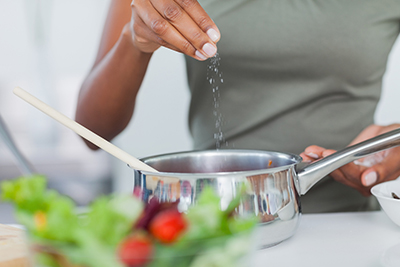Aim to eat at least 1,500 mg sodium a day and no more than 3,400 mg (around 2,000 mg is best for those with highly elevated blood pressure). One teaspoon of table salt has 2,300 mg sodium.
Sodium is a nutrient that is often misunderstood, and the salt shaker seems to get the blame for everyone’s high blood pressure. Some people are more sensitive to sodium than others and will see a greater increase in blood pressure from eating excess sodium. Sodium is a necessary nutrient, and eating too little sodium can be just as harmful as eating an excess. Salt is the most well-known source of sodium, but most of the sodium people eat comes from processed foods in the form of preservatives and additives. Excess sodium intake can modestly increase blood pressure, likely through a mechanism which causes blood vessels to constrict. The average amount of blood pressure reduction in studies of sodium restriction is between 2 and 5 mmHg which represents the numbers you get when your blood pressure is measured.*
Cooking Tips for Lowering Sodium Intake
As long as high-sodium processed foods and eating out are kept to a minimum, food at home can be salted “to taste” for cooking, and sodium intake will then usually fall within an appropriate range.
- Remember that one teaspoon of table salt has 2,300 mg sodium, enough for an entire day.
- If you are accustomed to eating your food heavily salted, try gradually cutting back to use less over time and allow your palate to adjust slowly.
- Salting food at the table with just a sprinkle on the surface of the food can also make for a saltier taste without using as much salt.
- Remember that some foods are naturally salty, like certain cheeses, preserved meats, and Asian food sauces, so keep the portions on those foods smaller.
- Cook with sea salt or Himalayan pink salt for a little boost of minerals with your salt.
- Read food labels to get an idea of how much sodium is in the foods you frequently eat.
- Choose products that are labeled low sodium or salt-free when shopping for canned goods.
- Store bought broth tends to be high in sodium even if purchasing the “lower sodium” varieties, so make broth at home when you can.
- Foods that come with flavoring packets and seasonings are typically going to be higher in sodium. Shop the perimeter of the store for fresh ingredients that are naturally lower in sodium.
- Buy sea salt or Himalayan pink salt for a little boost of minerals in your salt.

Shopping Tips for Lowering Sodium Intake
- Read food labels to get an idea of how much sodium is in the foods you frequently eat.
- Choose products that are labeled low sodium or salt-free when shopping for canned goods.
- Store bought broth tends to be high in sodium even if purchasing the “lower sodium” varieties, so make broth at home when you can.
- Foods that come with flavoring packets and seasonings are typically going to be higher in sodium. Shop the perimeter of the store for fresh ingredients that are naturally lower in sodium.
- Buy sea salt or Himalayan pink salt for a little boost of minerals in your salt.
